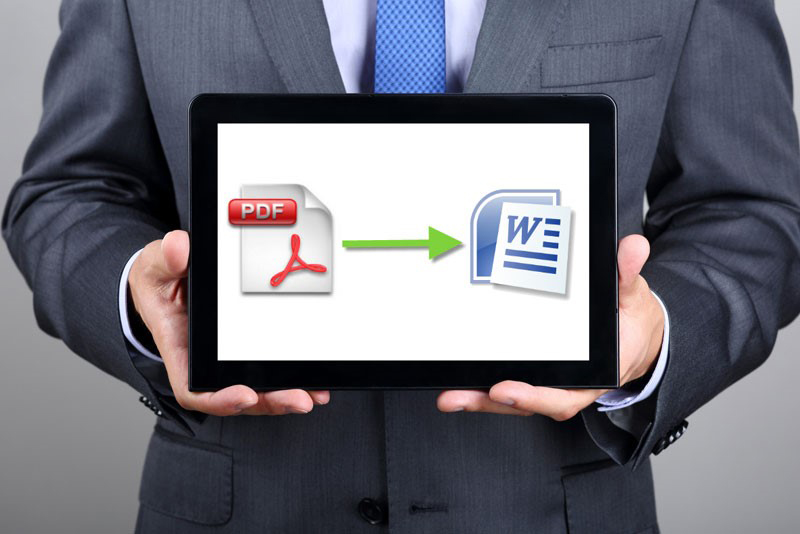Businesses work with different types of file formats. Every file format can support one or more forms of content such as images, video, and text. Some file formats can be only understood by specific programs, and would have to be converted into other formats to access them and maintain their usability. One of the most common solutions that a document conversion company provides is PDF to Word conversion.
PDF is ideal to display and share forms and long documents and for printing purposes. This file format prevents loss of information can be viewed on any device on which the Adobe Reader is installed. In addition to text, PDF files support photos, vector images, videos, audio files and even interactive elements like forms and buttons. The PDF format retains all formatting regardless of the device it is viewed on.
PDF to Word conversion is necessary:
- to edit or rework the content and change its formatting
- when the user’s computer does not have the PDF reader installed
There are several software options to convert PDF to Word, including advanced optical character recognition (OCR) applications.
Converting PDF to Word to edit the content would depend on the nature of the PDF file. If the PDF document was created from a Windows, Mac, or Linux app by exporting from the app to PDF, the text of the PDF would be embedded in the PDF file and can be extracted. On the other hand, if the PDF was created by scanning or photographing printed text, OCR would have to be sued on the scanned image to extract the text. Regardless of the method used, the conversion does not always happen perfectly. In other words, PDF to Word conversion is prone to errors and you would need to fix them.
Common Errors when Converting PDF to Word
Font types and sizes: OCR software is designed to read and convert a wide variety of fonts, but may not do so correctly. Too small/big characters would also be tricky to identify. The PDF reader can replace missing fonts with other fonts, Other problems that can occur include:
- Overlapping of characters
- Text appears scrambled, garbled, or displays as “garbage” characters
- Some text displays as subscript
- Text does not print correctly
Solution: PDF will convert properly if the text uses a basic font, like Times New Roman or Arial. Embedding fonts can prevent font substitution. This will ensure that the text is seen in its original font. All the selected fonts will remain embedded. Note that embedding a font is possible only if it has the font vendor has provided a setting that permits it to be embedded.
You can also set to keep the original file format. Follow these steps:
- Open Acrobat, and click Edit=>Preferences
- Access ‘Convert from PDF’, select the Word document
- Select Edit settings (edit settings) =>Retain Page Layout(keep page layout intact).
- Click OK
- Close and reopen Acrobat
Incorrect words: Two letters that appear close to each other are often misinterpreted by standard PDF to Word conversion algorithms and also OCR. For instance, “w” can be misinterpreted as “vv” or “Li” as “U”.
Solution: As Word’s spell check feature will highlight misspelled words, they can be detected and manually corrected by proofreading the document. If you detect one such spelling error, do a ‘search and replace’ to implement corrections in the entire document.
Issues with hyphenated words: If a word is hyphenated because it is split on two lines as in documents that use justified alignment, it can cause confusion in PDF to Word file conversion. If the Word page settings do not align with the original PDF document, the hyphens will be retained whether they are needed or not. So a word like organization may appear as organi-zation on one line.
Solution: Watch out for unnatural hyphenations when reviewing the converted file and delete them. As in the case of misspellings, use the CTRL+F function to find all hyphens and delete the inconsistent ones.
Bold, Underline and Italics Errors: OCR often fails to identify bold, underline and italic formatting, as well as mixed upper and lower case. Moreover, these elements may display in different font or even entirely different characters in the converted file. These bold, underline and italics are used to emphasize important points, names and titles, and cannot be ignored when converting PDF to Word.
Line break and column variations: Discrepancies in column widths, margins, and line spacing can impact the entire converted document. Common issues in this context include
- Line breaks do not align flawlessly in PDF and Word
- Line breaks appear in the wrong places
- Words, sentences and paragraphs can be moved up or down the page
Solution: Check margins and spacing in the converted file and make sure they meet your exact specifications. Misplaced line breaks can be detected by activating the “show invisibles” option, or changing the font size.
Multiple spaces: Words separated by multiple spaces can appear throughout the converted document.
Look-alike characters: OCR tools may not distinguish between some characters that look very similar, for e.g., the number “0” and the letter “O”.
Solution: Use the find and replace feature to address these problems.
Excluded links: Most online content contain links, but these elements can be excluded in PDF to Word conversion, more so when natural anchor text is used instead of the actual URL in the body of the text.
Solution: Proofread the document and make the necessary corrections
BPO companies offering Word conversion services can ensure accurate conversion for PDFs with embedded text and PDFs created through scanning. These services are especially useful for companies seeking cost-effective bulk document conversion solutions.
Streamline your PDF to Word conversion process with our outsourcing services!
Contact us today to find out how we can help you save time and avoid common conversion errors.




